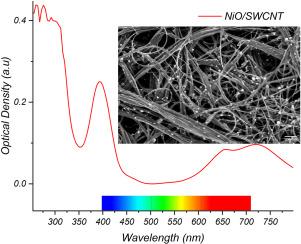Optical characterization of NiO nanoparticle-decorated single-walled carbon nanotubes synthesized via ultrasonic-assisted sol-gel method
IF 5.6
2区 材料科学
Q1 MATERIALS SCIENCE, CERAMICS
引用次数: 0
Abstract
The decoration of carbon nanotubes with metal oxide nanoparticles has been employed to enhance their intrinsic properties and expand their applicability across various technological fields. This study investigated the functionalization of single-walled carbon nanotubes (SWCNTs) by treating them with a 3:2 mixture of sulfuric acid and nitric acid, which introduces oxygen-containing functional groups to enhance their dispersibility and reactivity. Nickel oxide nanoparticles (NiONPs) were synthesized and integrated onto the functionalized SWCNTs using an ultrasonic-assisted sol-gel technique, allowing uniform distribution. Then, the NiONP/SWCNT composite was evaluated for thermal stability and elemental composition via thermogravimetric analysis (TGA) and energy-dispersive X-ray spectroscopy. Both field emission scanning electron microscopy and high-resolution transmission electron microscopy confirmed the successful decoration of NiONPs (particle size <20 nm, mean value of 7.87 ± 3.02 nm) on the SWCNTs. Fourier-transform infrared spectroscopy revealed characteristic peaks corresponding to NiO at 644 cm−1 as IR-active modes induced by NiO–SWCNT and Raman spectroscopy further verified the chemical bonding between NiONPs and SWCNTs. This shows shifts in the radial breathing mode and G bands of SWCNTs, indicative of strong interfacial chemical interactions. Optical analysis demonstrated that the NiO-SWCNT nanocomposite exhibited a reduced band gap compared to pure NiO nanoparticles but a broader band gap than intermediate-phase SWCNT configurations. In addition, UV–Vis spectroscopy identified a prominent absorption peak within the 600–800 nm wavelength range, aligning with the near-infrared (NIR) spectral region. This enhanced NIR absorption suggests improved light-capturing efficiency, which could significantly benefit applications in photocatalysis and optoelectronics.

超声辅助溶胶-凝胶法制备NiO纳米颗粒修饰单壁碳纳米管的光学表征
利用金属氧化物纳米粒子对碳纳米管进行修饰,可以增强碳纳米管的内在性能,扩大其在各个技术领域的适用性。本研究通过用3:2的硫酸和硝酸处理单壁碳纳米管(SWCNTs)来研究其功能化,通过引入含氧官能团来增强其分散性和反应性。利用超声辅助溶胶-凝胶技术合成了氧化镍纳米颗粒(NiONPs),并将其整合到功能化的SWCNTs上,使其均匀分布。然后,通过热重分析(TGA)和能量色散x射线光谱对NiONP/SWCNT复合材料的热稳定性和元素组成进行了评估。场发射扫描电镜和高分辨率透射电镜均证实在SWCNTs上成功修饰了NiONPs(粒径<; 20nm,平均值7.87±3.02 nm)。傅里叶变换红外光谱在644 cm−1处显示了NiO对应的特征峰,这是NiO - SWCNTs诱导的红外活性模式,拉曼光谱进一步验证了NiONPs与SWCNTs之间的化学键合。这表明SWCNTs的径向呼吸模式和G带发生了变化,表明存在强的界面化学相互作用。光学分析表明,与纯NiO纳米颗粒相比,NiO-SWCNT纳米复合材料的带隙减小,但比中间相SWCNT结构的带隙更宽。此外,紫外可见光谱在600 ~ 800 nm波长范围内发现了一个突出的吸收峰,与近红外(NIR)光谱区对齐。这种增强的近红外吸收表明提高了光捕获效率,可以显著地促进光催化和光电子学的应用。
本文章由计算机程序翻译,如有差异,请以英文原文为准。
求助全文
约1分钟内获得全文
求助全文
来源期刊

Ceramics International
工程技术-材料科学:硅酸盐
CiteScore
9.40
自引率
15.40%
发文量
4558
审稿时长
25 days
期刊介绍:
Ceramics International covers the science of advanced ceramic materials. The journal encourages contributions that demonstrate how an understanding of the basic chemical and physical phenomena may direct materials design and stimulate ideas for new or improved processing techniques, in order to obtain materials with desired structural features and properties.
Ceramics International covers oxide and non-oxide ceramics, functional glasses, glass ceramics, amorphous inorganic non-metallic materials (and their combinations with metal and organic materials), in the form of particulates, dense or porous bodies, thin/thick films and laminated, graded and composite structures. Process related topics such as ceramic-ceramic joints or joining ceramics with dissimilar materials, as well as surface finishing and conditioning are also covered. Besides traditional processing techniques, manufacturing routes of interest include innovative procedures benefiting from externally applied stresses, electromagnetic fields and energetic beams, as well as top-down and self-assembly nanotechnology approaches. In addition, the journal welcomes submissions on bio-inspired and bio-enabled materials designs, experimentally validated multi scale modelling and simulation for materials design, and the use of the most advanced chemical and physical characterization techniques of structure, properties and behaviour.
Technologically relevant low-dimensional systems are a particular focus of Ceramics International. These include 0, 1 and 2-D nanomaterials (also covering CNTs, graphene and related materials, and diamond-like carbons), their nanocomposites, as well as nano-hybrids and hierarchical multifunctional nanostructures that might integrate molecular, biological and electronic components.
 求助内容:
求助内容: 应助结果提醒方式:
应助结果提醒方式:


